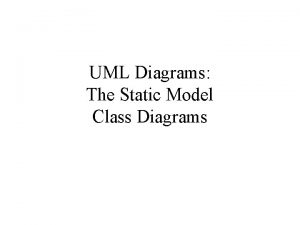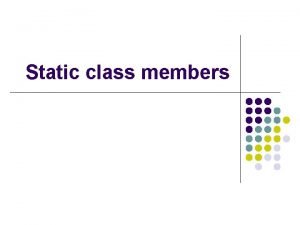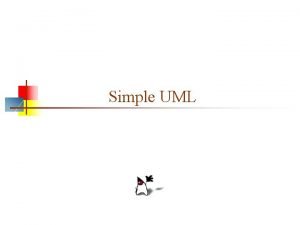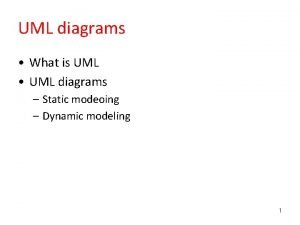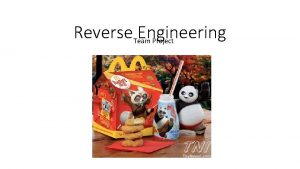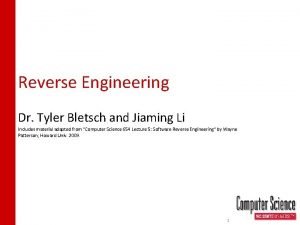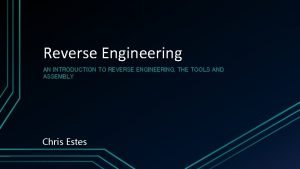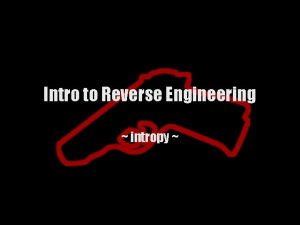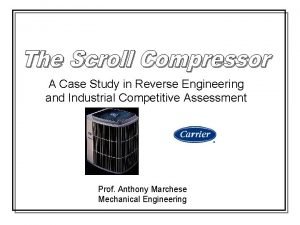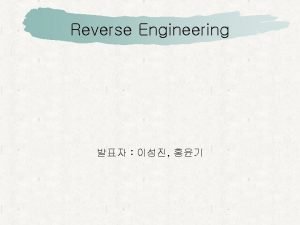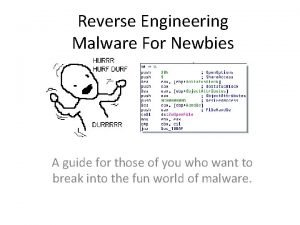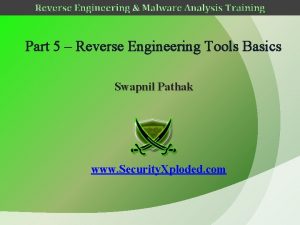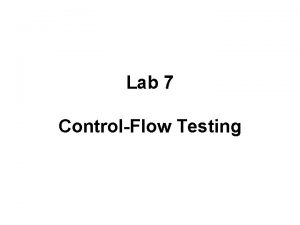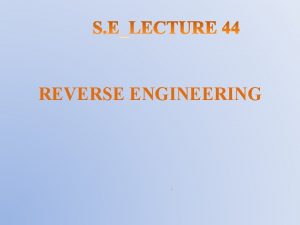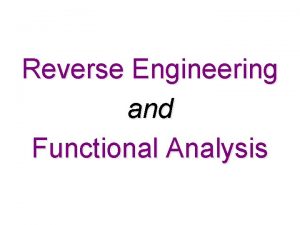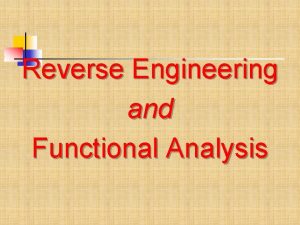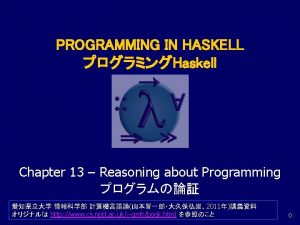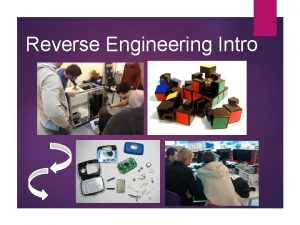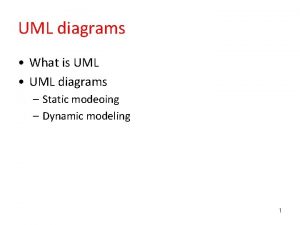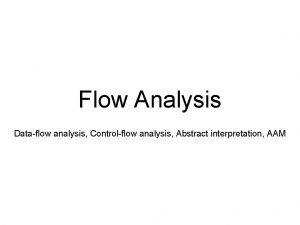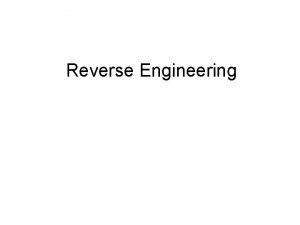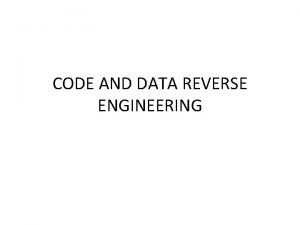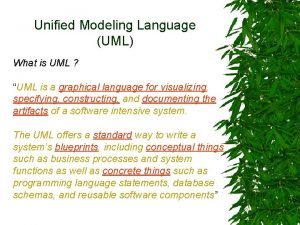Static ControlFlow Analysis for Reverse Engineering of UML















![Average Running Time per Method [milliseconds] PRESTO Research Group - Ohio State University Nasko Average Running Time per Method [milliseconds] PRESTO Research Group - Ohio State University Nasko](https://slidetodoc.com/presentation_image_h2/868cd7b377454c27f9b84ecab6aaf769/image-16.jpg)




- Slides: 20

Static Control-Flow Analysis for Reverse Engineering of UML Sequence Diagrams Atanas (Nasko) Rountev Ohio State University with Olga Volgin and Miriam Reddoch

Example of a UML Sequence Diagram start: X p: A m 1() m 2() m 3() create() opt n: A m 4() PRESTO Research Group - Ohio State University Nasko Rountev PASTE'05 2

UML Sequence Diagrams § § § Popular UML artifacts for modeling of object interactions Design-time sequence diagrams Reverse-engineered sequence diagrams § Based on existing code § Iterative development; design recovery for software maintenance; software testing § Implemented in some commercial UML tools PRESTO Research Group - Ohio State University § Nasko Rountev PASTE'05 Together Control. Center (Borland) 3

Reverse-Engineering Analyses Dynamic analysis: tracks a set of representative run-time executions § Several research tools § Static analysis: examines only the code § Commercial tools (deficiencies) § Some research work (not comprehensive) § RED tool for Java: PRESTO group at OSU § URL: presto. cse. ohio-state. edu/red PRESTO Research Group - Ohio State Nasko Rountev § Call chain analysis; control-flow University PASTE'05 4 §

Representation of Intraprocedural Flow of Control Given: the methods whose bodies will be used to construct the diagram § How should we represent the intraprocedural flow of control inside intra these bodies? § Solution: general algorithm for mapping a method’s CFG to UML 2. 0 interaction fragments § Any reducible exception-free CFG § Precise mapping: preserves all call sequences PRESTO Research Group - Ohio State Nasko Rountev § Subsequent diagram transformations § University PASTE'05 5

UML 2. 0 Interaction Fragments § Opt, alt, loop, break; added generalized break PRESTO Research Group - Ohio State University Nasko Rountev PASTE'05 6

Analysis Stages CFG Phase I: Preprocessing Phase II: Fragment Construction Phase III: Transformations Data Structure for Fragments PRESTO Research Group - Ohio State University Nasko Rountev PASTE'05 7

Phase I: Preprocessing Post-dominance tree § Node n 2 post-dominates n 1 if all paths from n 1 to exit go through n 2 § Immediate post-dominator; parent in the tree § Analyze branch nodes § What is the merge point for all branches? § Analyze loops § Nesting relationships PRESTO Research Group - Ohio State Rountev § What is the merge point for. Nasko all loop University PASTE'05 § 8

Post-dominance Tree PRESTO Research Group - Ohio State University Nasko Rountev PASTE'05 9

Branch Nodes and Branch Successors § Branch successor: node where the outgoing paths for a branch node merge the branch successo r of 3 is 6 PRESTO Research Group - Ohio State University Nasko Rountev PASTE'05 10

Loops and Loop Successors § § Reducible CFG: contains only natural loops Loop successor: merge point of all paths exiting the loop success or of L is 12 PRESTO Research Group - Ohio State University Nasko Rountev PASTE'05 11

Branch/Loop Successors Inside Loop L § § Consider only edges inside L Create a post-dominance tree for L and use it for: § branch successors for nodes in L § loop successors for loops nested in L the branch successo r PRESTO Research Group Ohio of- 7 is State 10 University Nasko Rountev PASTE'05 12

Analysis Stages CFG Phase I: Preprocessing Phase II: Fragment Construction Phase III: Transformations Data Structure for Fragments PRESTO Research Group - Ohio State University Nasko Rountev PASTE'05 13

Phase II: Fragment Construction TOP 1: i = -1 Pattern. Entry: get. Chars() 2: s = e. get. Chars() ALT 1 cond: s != null String: char. At(0) T 3 : s != null F Vector: index. Of(e) 4 5: i = patterns. index. Of(e) : e = s. char. At(0) LOOP 1 cond: i>= 0 F 6: i>=0 BREAK 1 T F 7: status. Array[i] !=0 OPT 1 T cond: i<0 breaks_from: LOOP 1 cond: status. Array[i] !=0 Vector: element. At(i) 8 : e 1 = patterns. element. At(i) 9: e 1 != null BREAK 2 cond: e 1 != null breaks_from: LOOP 1 T Merge. Collation: fix. Entry(e 1) F 10 : patterns. remove. Element. At(i) 11 : fix. Entry(e 1) Vector: remove. Element. At(i) 12: exit PRESTO Research Group - Ohio State University Nasko Rountev PASTE'05 14

Various Issues § UML additions § Multi-level break fragments § Multiple method exits Opt-like fragments: return fragments § Algorithm uses info about control dependencies § § Exceptions (Java) “throw e”: similar to method exit - throw fragment § Ignore catches and implicit exceptions § Node replication: the same CFG node PRESTO Research Group State Rountev may have to- Ohio produce multiple. Nasko identical § University PASTE'05 15
![Average Running Time per Method milliseconds PRESTO Research Group Ohio State University Nasko Average Running Time per Method [milliseconds] PRESTO Research Group - Ohio State University Nasko](https://slidetodoc.com/presentation_image_h2/868cd7b377454c27f9b84ecab6aaf769/image-16.jpg)
Average Running Time per Method [milliseconds] PRESTO Research Group - Ohio State University Nasko Rountev PASTE'05 16

Methods Requiring Return/Throw Fragments PRESTO Research Group - Ohio State University Nasko Rountev PASTE'05 17

Methods Requiring Multi-level Break Fragments PRESTO Research Group - Ohio State University Nasko Rountev PASTE'05 18

Methods Requiring Node Replication PRESTO Research Group - Ohio State University Nasko Rountev PASTE'05 19

Summary and Future Work § § General and fast algorithm § Creates detailed and precise representation Subsequent simplifications § Lossless: e. g. merge a fragment with the surrounding fragment [OSUCISRC-3/04 -TR 12] Lossy: e. g. give up on multi-level breaks § Interactive visualization [VISSOFT’ 05] § Collapse and un-collapse fragments; PRESTO Research Group - Ohio State w. r. t. a fragment Nasko Rountev slice the diagram of University PASTE'05 20 § University PASTE'05 20
 Forward engineering and reverse engineering
Forward engineering and reverse engineering Forward and reverse engineering
Forward and reverse engineering Functional analysis for engineers
Functional analysis for engineers Structural analysis reverse engineering
Structural analysis reverse engineering Interaction overview diagram
Interaction overview diagram What is uml
What is uml Uml class diagram static
Uml class diagram static Uml static
Uml static Uml static method
Uml static method Uml static variable
Uml static variable Static and dynamic uml diagrams
Static and dynamic uml diagrams переводчик
переводчик Cuckoo static analysis
Cuckoo static analysis Reverse engineering team
Reverse engineering team Codebreaker challenge
Codebreaker challenge Intro to reverse engineering
Intro to reverse engineering Intro to reverse engineering
Intro to reverse engineering Reverse engineering case study
Reverse engineering case study Ollydbg reverse engineering
Ollydbg reverse engineering Reverse engineering guide
Reverse engineering guide Malware reverse engineering training
Malware reverse engineering training







